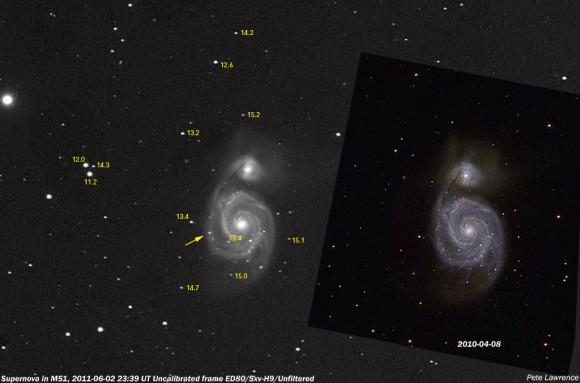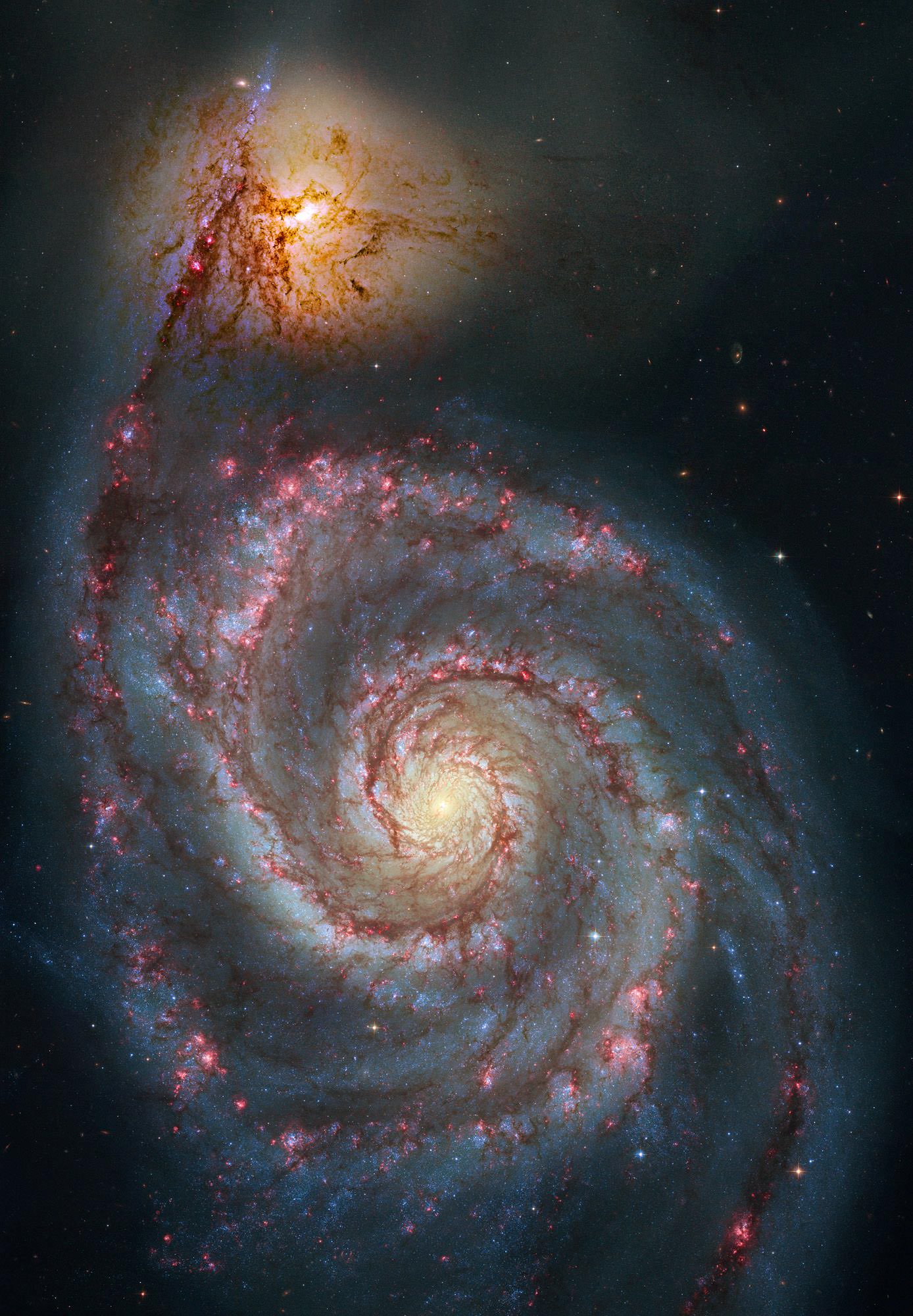A new supernova (exploding star) has been discovered in the famous Whirlpool Galaxy, M51.
M51, The Whirlpool galaxy is a galaxy found in the constellation of Canes Venatici, very near the star Alkaid in the handle of the saucepan asterism of the big dipper. Easily found with binoculars or a small telescope.
The discovery was made on June 2nd by French astronomers and the supernova is reported to be around magnitude 14. More information (In French) can be found here or translated version here.

The supernova will be quite tricky to spot visually and you may need a good sized dobsonian or similar telescope to spot it, but it will be a easy target for those interested in astro imaging.
The whirlpool galaxy was the first galaxy discovered with a spiral structure and is one of the most recognisable and famous objects in the sky.


and possibly a progenitor star (18-24 solar masses!)
http://www.astronomerstelegram.org/?read=3401
Clear skies in Vancouver! Seems like it’s been months … I’m going to try and capture this tonight with one of my crude but fun unguided stacks of 30 second exposures.
See avishay’s post below on where to submit images. Good luck!
Awesome work Ken!!
Aw heck, I imaged the supernova on May 31 but didn’t notice it until after I saw this article. Does that count? 🙂
I got it May 31 at 8:54UT on a Takahashi FS 102.
I got it May 31 at 8:54UT on a Takahashi FS 102.
Ditto. See avishay’s post below.
Sounds like you were just in time. See avishay’s post below.
Unfortunately, no. Lots of discoveries are verified by looking at old images, often the images on glass plates that were taken decades ago. Amateurs also make discoveries while examining images and data from Hubble and other sources well after the images were captured. Discoveries are credited to those who realize they’ve discovered something, figure out what it is, and then make it known.
I would add to Kahn’s post that even if you’re not the first (or second, third…etc.) to discover a particular supernova, having good, documented images of the SN in the days following the outburst can be very important to astronomers studying the light curve of the event.
Even images taken in the hours before the SN event is reported, where no light from the SN is yet visible in your images, can give astronomers an upper limit to the brightness of the event at that time (during the ultra-brief rise time to maximum light). So it makes sense to carefully examine all images of a galaxy with a reported supernova taken before AND after the SN reaches maximum light (….again see avishay’s post below).
(one caveat being that the SN is bright enough at maximum to be well imaged with your camera-scope setup)
At the fourth paragraph, it should be the indefinite article an, not “a”, in the second line: “…, but it will be a easy target…”
How did I miss these type of comments of yours 😀
We get this from a guy who puts numbers in his nick?
Seeing how some have reported this event taking place right around June 1st I for one will remember it as Norma Jeane Baker’s Nova in remembrance of Marilyn Monroe.
I have images that show it happened on May 31, 2011/
See avishay’s post below.
This is a very exciting scientific discovery, to which amateurs can further significantly contribute! We at the Palomar Transient Factory seek more image data of M51 obtained between May 30 and June 2, 2011. So, if you have imaged this galaxy using a telescope and a digital camera, your data may be very useful to this project!
Helpful data would be:
* only if it is of M51 between May 30 and June 2
* only if it is has an accurate time stamp.
In case such data exists, please send the raw images, specify the filter(s) used and if possible send images of the same field taken with the same instrument and telescope before May 30, all to: [email protected] Your help could be crucial for great scientific discoveries! we will not use any data without permission, and will of course credit all useful images.
Many thanks Iair Arcavi and Avishay Gal-Yam (for the PTF)
I don’t see it.
Hi
I take this Nova in 3/6/2001 in M51 . share in facebook.
http://www.facebook.com/photo.php?fbid=2135729192749&set=a.1262146033716.40476.1231666084&type=1&ref=nf